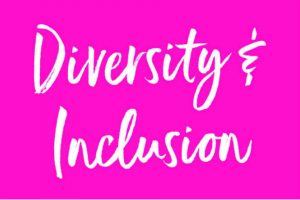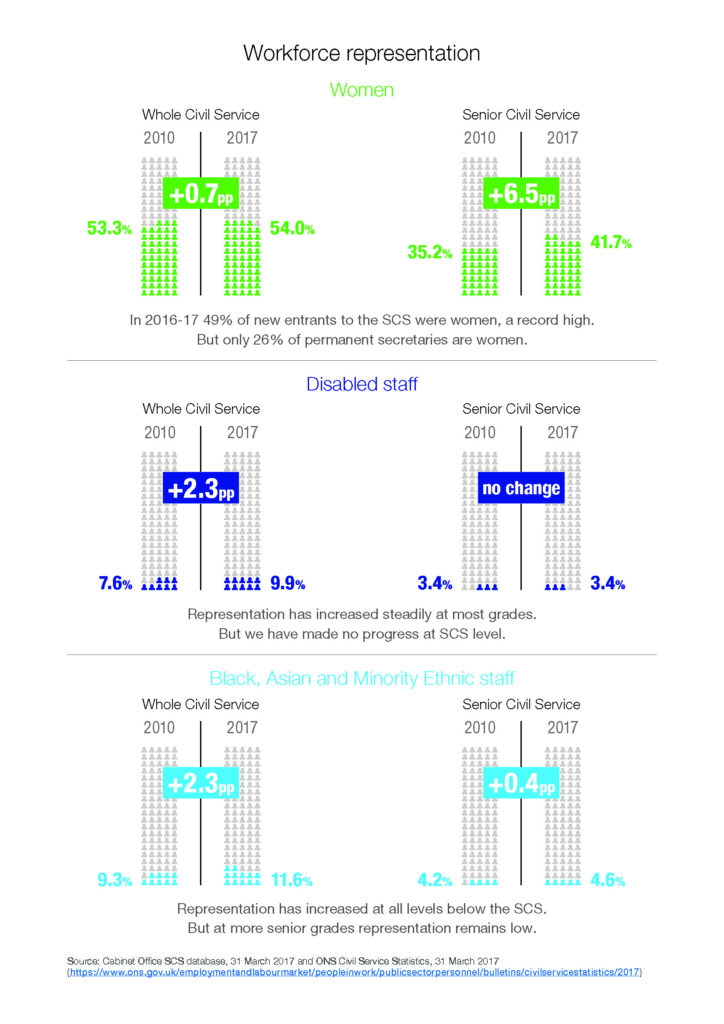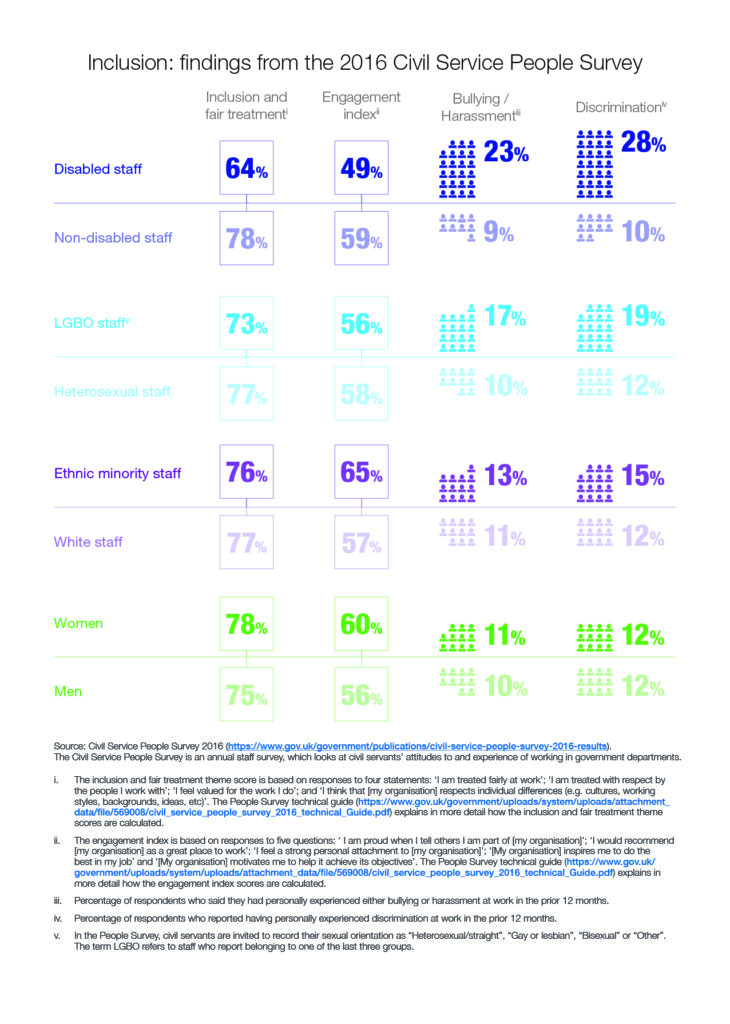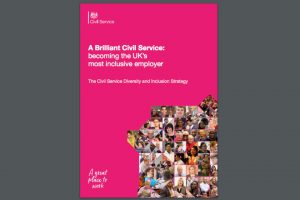
Allow me to clarify: there are some caveats to this bold statement. In an ideal world, my team and I would not be needed.
My job as Head of Civil Service Diversity & Inclusion (D&I) exists because the Civil Service is committed to reflecting the society that we serve and be an inclusive organisation where everyone can be who they are and perform at their best.
Sir Jeremy Heywood, Head of the Civil Service, has set diversity and inclusion as one of his top three business priorities for the Civil Service, and in the Civil Service Workforce Plan 2016-2020 we set out a challenging ambition for the Civil Service to become the most inclusive employer in the UK by 2020.
It is my job to make evidence-based decisions on the shifts in policy or behaviours required to achieve this. But it’s you, all of us, who will need to deliver the change.
What do we mean by diversity and inclusion?
 In the context of the Civil Service, we measure diversity by representation and the extent to which we reflect the communities that we serve (see Workforce representation graphic, below).
In the context of the Civil Service, we measure diversity by representation and the extent to which we reflect the communities that we serve (see Workforce representation graphic, below).
We are making steady progress on the representation of women: nearly 42% of the Senior Civil Service (SCS) is now made up of women, compared to just 35% in 2010. In 2016 almost 49% of newly appointed SCS were women. However, although the proportion of women in the SCS is greater than the representation of female executives and board directors in FTSE 100 companies (26%), this masks much lower representation in the most senior roles and variation between departments.
On ethnicity and disability the picture is stark. When we compare the Civil Service with the UK’s economically active population, we find that people from ethnic minority backgrounds continue to be under-represented at all grades except EO (Executive Officer). Representation gets lower at more senior grades. In the SCS the proportion of staff who are from an ethnic minority background (4.6%) has only changed very slightly in recent years. As with gender, representation is lower at the most senior levels.
Representation of disabled staff is increasing at Grade 6 and below. However, representation is well below that in the economically active population at all grades, and representation of disabled staff in the SCS has barely changed since 2010.
We cannot accurately measure how well lesbian, gay and bisexual staff are represented, as fewer than half of civil servants report their sexual orientation and we do not routinely gather information on gender identity. Making sure that people can record their information easily, and that they feel comfortable doing so, will be an important aspect of our future work plan.

However, the real question is not how many people we are recruiting from under-represented groups, but rather the quality of their experience working in the Civil Service. Or, as American diversity advocate Vernã Myers puts it, “diversity is being invited to the party; inclusion is being asked to dance”.
On inclusion, the experience of different groups varies quite dramatically. The biggest gaps are for disabled staff, who are much more likely to experience discrimination, bullying and harassment and have much lower engagement scores (see Inclusion graphic, below).

Yet we don’t see inclusion as being solely about under-represented groups: it is so much more than that. When we talk about inclusion, we are talking about all of our people. Everyone wants to be included at work, and when we exclude people we diminish their input and their potential to contribute. Inclusion is about the introvert in a room full of extroverts struggling to be heard. It’s about the person who always misses the team meeting because it’s on their home working day. It’s about the assumption that only young people have fresh and creative ideas. It’s about you.
Inclusion creates the quality of environment where we are all able to ‘be ourselves’ at work: able to be different from each other in many ways and to feel supported, empowered, valued, respected and fairly treated. Organisations that are more inclusive are also more attractive to prospective talented employees and are places where we can all thrive. Getting this right means all of us being able to build successful careers and achieve our potential - which in turn makes us a better Civil Service, delivering better services and outcomes for citizens.
Diversity without inclusion simply cannot happen
 With all our evidence clearly pointing to a persistent lower quality of experience for many of our employees, we have designed a new Civil Service Diversity and Inclusion Strategy, which balances our efforts between:
With all our evidence clearly pointing to a persistent lower quality of experience for many of our employees, we have designed a new Civil Service Diversity and Inclusion Strategy, which balances our efforts between:
-
- increasing the representation of underrepresented groups at all levels within all parts of the Civil Service; and
- focusing on inclusion to build an organisation that attracts, retains and nurtures the best and most diverse talent possible, making us a better Civil Service, delivering improved services and outcomes.
The new strategy pushes us out of our comfort zone and challenges the cultures - and micro-cultures - of the vast organisation that is the Civil Service.
This is a strategy for the people, by the people. In designing it, we have sought the views of civil servants at all levels. The team attended ten sessions at Civil Service Live this year and received feedback that was both really positive but also challenging, highlighting the concerns staff had in relation to D&I.

Clear themes for improvement emerged from our discussions, including:
-
- issues around age (younger and older staff) and disability discrimination;
- lack of understanding around carer responsibilities and carer’s passport availability;
- exclusive behaviours resulting from team hierarchy;
- unconscious bias affecting equal opportunities for development; and
- the use of careless, unprofessional and discriminatory language in the workplace relating to gender, faith and sexual orientation.
We have taken this feedback seriously and used it to shape our strategy. We have also consulted with employee networks, heads of diversity, functions and professions.
If inclusion is about quality of experience, how do we measure it?
We will work with other employers to agree a clear definition and a common set of measures of inclusion. We will lead, in partnership with the Chartered Institute for Personnel Development (CIPD), the establishment of a new framework for the measurement of inclusion. This will be used across the Civil Service and by other employers, to assess and benchmark performance. In doing this, we will build on the path-breaking work done on measures of Socio-Economic Background (SEB).
Inclusion is an indicator and product of good leadership and management. Research finds that employees with inclusive managers are more likely to feel that their innovative potential is unlocked. Employees who are able to bring their whole self to work are 42% less likely to say they intend to leave their job within a year. We will establish quality standards for inclusive leadership, valuing and embedding inclusion within our capability standards and performance measures for all Civil Service leaders. These standards will be threaded through the work of the Leadership Academy, our selection processes, career pathways and performance management approaches.
Our data tells us that staff from under-represented groups have poorer outcomes on a range of measures associated with inclusion such as discrimination, bullying and harassment; and engagement varies hugely between groups. We cannot get the best out of our staff if they feel excluded, bullied or disengaged and we will not tolerate negative behaviours. Therefore, we will take forward a programme of culture audits across the Civil Service, working with departments, professions and functions to identify where action should be taken. We will take an evidence-based approach towards inclusion, but not be slow to innovate where required.
So, when am I out of a job?
We know we will have got there when the Civil Service is not only representative of our society, at all grades and across all departments, but when everyone’s dance card is full.
Recent Comments